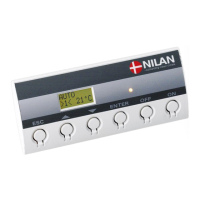May be subject to change page 10 of 27
Alarm codes are given because of a fault situation or when it is important to inform the user.
The alarms are divided into the following categories:
Operation is partly or completely stopped as long as the alarm is active.
These types of alarms will become critical if the problem is not solved quickly.
Normal operation is not affected. Alarm disappears when it is reset.
Error in control hardware
Contact service if reset does
not help
Warning alarm W has become a
critical alarm.
Note and reset the alarm.
Contact service if alarm does
not disappear.
Fire detecting thermostat.
Unit is stopped because the fire
detecting thermostat has been
activated.
If there has not been a fire
please contact service.
High or low pressure switch in the
cooling circuit has been triggered,
probably caused by:
High pressure:
Extreme hot
Cloaked filter
Defective fan
Low pressure:
Extreme cold
Unit might have lost coolant
Cloaked filter
Defective fan
Check for errors and reset
alarms.
If you are unable to reset the
alarm or if the alarm occurs
often please contact service.
The unit is defrosting.
The frost protection of the heat
recovery system is insufficient
and the unit will stop. This can be
caused by extreme low outdoor
temperatures
Contact service if reset does
not help. Note the actual
sensor temperatures from
the menu “Show data” to
help service.
The water from the central heat-
ing is too cold.
Check that the heating sup-
ply for the heating surface is
OK. Reset alarm when fault
has been repaired.
One of the temperature sensors in
the unit is short circuit or defect.
Note the sensor and contact
service.
The electrical heating element is
overheated. Lack of airflow due to
cloaked filters, cloaked air intake
or defect inlet fan.
Check if air flows into the
house.
Check filter and air intake.
Reset alarm.
Contact service if the above
does not help.
Relay is triggered ventilation. This
may be due to defects in the fan
or low voltage

